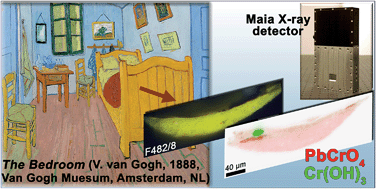Full spectral XANES imaging using the Maia detector array as a new tool for the study of the alteration process of chrome yellow pigments in paintings by Vincent van Gogh†
Abstract
A combination of synchrotron radiation (SR) micro X-ray fluorescence (μ-XRF) and XRF mode X-ray absorption near edge structure (XANES) measurements at the Cr K-edge already allowed us to establish that the photo-reduction of chromates to Cr(III) compounds is the cause of darkening of chrome yellow pigments (PbCr1−xSxO4, 0 ≤ x ≤ 0.8) in a number of paintings by Vincent van Gogh and in corresponding artificially aged paint models. A silicon drift detector (SDD) was employed to record the Cr-K XRF radiation in these X-ray micro beam-based measurements. However, in view of the limited count rate capabilities and collection solid angle of a single device, μ-XRF and μ-XANES employing single element SDDs (or similar) are primarily suited for collection of spectral data from individual points. Additionally, collection of XRF maps via point-by-point scanning with relatively long dwell times per point is possible but is usually confined to small areas. The development of the 384 silicon-diode array Maia XRF detector has provided valuable solutions in terms of data acquisition rate, allowing for full spectral (FS) XANES imaging in XRF mode, i.e., where spectroscopic information is available at each pixel in the scanned map. In this paper, the possibilities of SR Cr K-edge FS-XANES imaging in XRF mode using the Maia detector are examined as a new data collection strategy to study the speciation and distribution of alteration products of lead chromate-based pigments in painting materials. The results collected from two micro-samples taken from two Van Gogh paintings and an aged paint model show the possibility to perform FS-XANES imaging in practical time frames (from several minutes to a few hours) by scanning regions of sample sizes of the same order (more than 500 μm). The sensitivity and capabilities of FS-XANES imaging in providing representative chemical speciation information at the microscale (spatial resolution from ∼2 to 0.6 μm) over the entire scanned area are demonstrated by the identification of Cr(OH)3, Cr(III) sulfates and/or Cr(III) organometallic compounds in the corresponding phase maps, as alteration products. Comparable Cr-speciation results were obtained by performing equivalent higher spatial resolution SR μ-XRF/single-point μ-XANES analysis using a more conventional SDD from smaller regions of interest of each sample. Thus, large-area XRF mode FS-XANES imaging (Maia detector) is here proposed as a valuable and complementary data collection strategy in relation to “zoomed-in” high-resolution μ-XRF mapping and single-point μ-XANES analysis (SDD).

- This article is part of the themed collection: Synchrotron radiation and neutrons in art and archaeology


 Please wait while we load your content...
Please wait while we load your content...